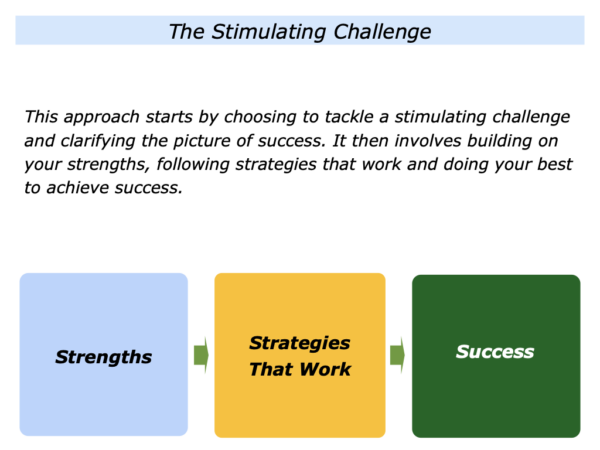
This approach starts by choosing to tackle a stimulating challenge and clarifying your goals. It then involves building on your strengths, following strategies that work and doing your best to achieve success.
Looking back, can you think of a situation when you followed elements of this approach? This could have been something you did in your personal or professional life.
You may have been aiming to improve your health, find a job or do a creative project. You may have been managing a crisis, tackling a problem or doing another activity.
What motivated you to tackle the challenge? How did you clarify your goals? How did you then to your best to achieve the picture of success? What happened as a result of taking these steps?
If you wish, try tackling the exercise on this theme. This invites you to complete the following sentences.
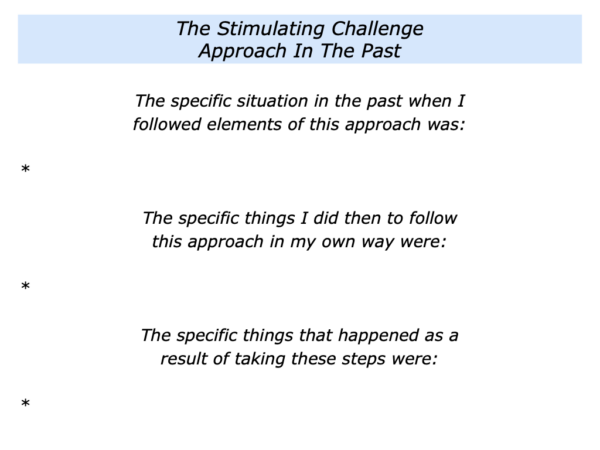
Imagine that you want to follow elements of this approach in the future. If appropriate, you may wish to take the following steps.
You Can Choose To Tackle What
You Define As A Stimulating Challenge
This step involves two interrelated parts. It involves: a) you choosing to tackle a specific challenge; b) you choosing to define it as a stimulating challenge. Different people take such decisions for different reasons.
Some people aim to take more control of their lives. They then reframe the situation in a positive way. They see how tackling a specific challenge will bring more pleasure, less pain or have other positive benefits.
Some people choose to take responsibility out of a sense of duty. They look at the situation and ask the following questions. What needs to be done and who needs to do it? If not me, then who? They then choose to tackle the challenge.
Some people reframe a situation as an opportunity to follow their life principles. Some see it as a chance to build on their strengths, put themselves into a stimulating situation and do their best to achieve success.
Dennis Charney and Steven Southwick described how some people take this approach in their book Resilience: The Science of Mastering Life’s Greatest Challenges. Here is a summary of their findings.
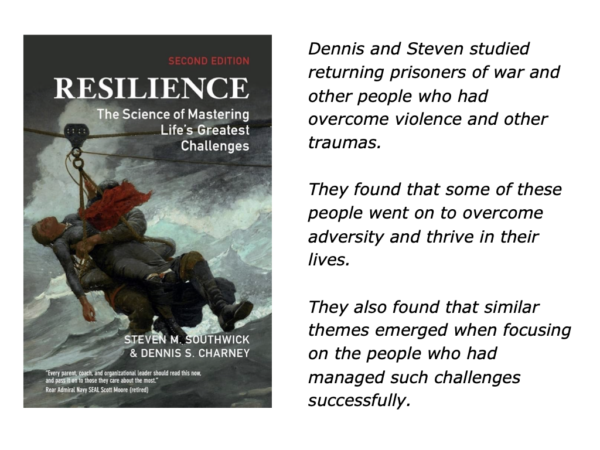
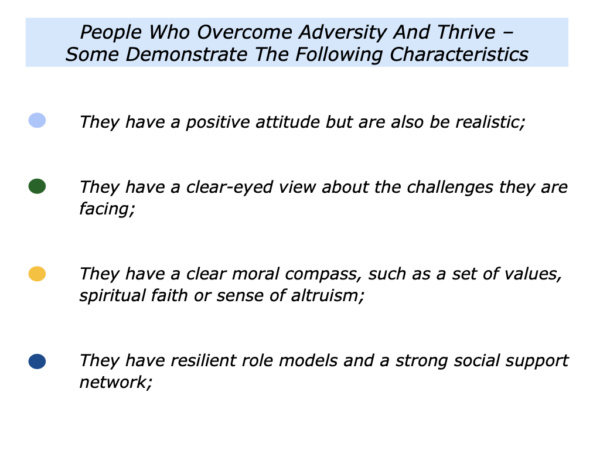
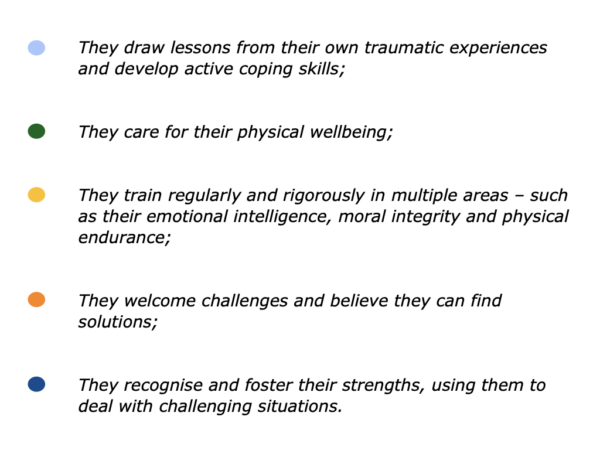
Let’s return to your own life and work. Looking ahead, can you think of a situation where you may choose to tackle a challenge that you define as a stimulating?
What may be the challenge you want to tackle? How could you reframe it in a positive way? What may be the benefits – for yourself or other people – of tackling the challenge?
Imagine that you have taken this step. It can then be time to move on to the next stage.
You Can Clarify The
Picture Of Success
People who choose to tackle a challenge often focus on the real results they want to achieve. Some then get extra motivation by focusing on the benefits of achieving this picture of success.
Ellen MacArthur is somebody who follows this approach. She did this as a yachtswoman and now when enabling people to build a circular economy. The following piece is taken from her foundation’s website.
In 2005, Ellen MacArthur became the fastest solo sailor to sail around the world. Five years later, she set up the Foundation in her name to accelerate the transition to a circular economy.
After circling the globe – carrying everything she needed with her – she returned with new insights into the way the world works, as a place of interlocking cycles and finite resources, where the decisions we make today affect what’s left for tomorrow.
Spending 71 days alone at sea, confronted by the awesome power and dazzling beauty of nature, Ellen began to ponder the fragility of the systems we’ve built.
Her boat was her world and her survival was entirely dependent on the limited food, fuel, and other supplies she’d brought with her. She realised that our global economy is no different – it relies completely on the finite resources we extract, use and then dispose of.
She found that the linear system in which we live is fundamentally flawed. She asked herself what would a successful economy that uses things, rather than uses them up look like?
After talking with business leaders, engineers and other experts, she concluded that building a system that could work in the long term is within our reach.
But we would need to transform our extractive, throwaway economic model to one that was based on the principles of a circular economy – an economy designed to keep materials in use, eliminate waste and regenerate natural systems.
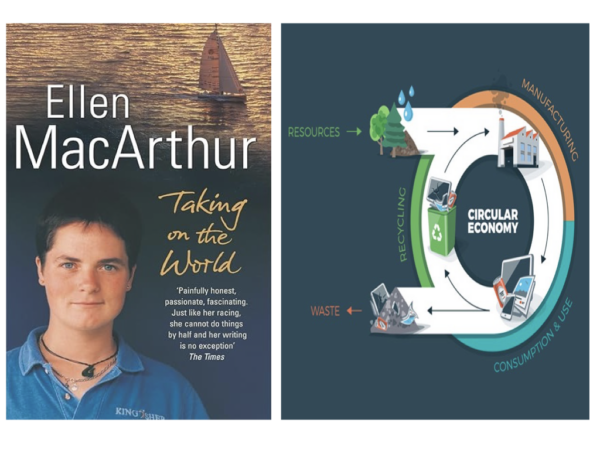
She did a massive amount of research before setting up the Ellen MacArthur Foundation. This now works with businesses, cities and other organisations that aim to apply the principles of a circular economy.
Ellen recognises that people are more likely to make changes when they see that these will be beneficial. The foundation therefore aims to deliver projects that provides financial or other positive benefits.
Let’s return to your own life and work. Imagine that you want to tackle a stimulating challenge. Bearing in mind what you can control in the situation, it can be useful to explore the following themes.
What are the real results I want to achieve? What is the picture of success? What will be the benefits of achieving the goals? What will be happening that will show I have achieved the picture of success?
Let’s assume you have clarified your aims. Before setting out on the journey, it can then be useful to focus on the following theme.
You Can Build
On Your Strengths
Great workers often build on their strengths when aiming to tackle a challenge. Different people follow this approach in different ways. Some do it by exploring the following themes.
What are my strengths? What are the areas in which I deliver As rather than Bs or Cs? How can I use these to tackle the challenge? What other skills do I need to add?
What is my successful style of working? When have I tackled a similar challenges successfully in the past? What did I do right then? How can I follow similar principles to tackle the present challenges successfully?
Let’s return to how you can tackle your chosen challenge. How can you build on your strengths and follow your successful style? If appropriate, how can you work with people who have complementary strengths?
Imagine that you have clarified how you can build on your strengths. Bearing in mind the goal you want to achieve, it can then be useful to focus on the next step.
You Can Follow
Strategies That Work
Great workers study what works. They study success in life, education, creativity, business, sports, social enterprises and other fields. They then apply these strategies in their own way to achieve success.
Bearing in mind the challenge they want to tackle, some people explore the following questions.
What are the strategies that work in this area? What do people, teams or organisations do to achieve success? What are the principles they follow? How do they translate these into action?
Bearing in mind my strengths, how can I follow these principles in my own way? What are the key strategies I can follow to give myself the greatest chance of success? How can I encourage myself along the way?
How can I translate the strategies into action? How can I anticipate and manage any challenges? How can I clarify what is working and what can be done better? How can I do my best to achieve the picture of success?
As mentioned earlier, some people study what has worked in different fields. People who want to improve life on the planet, for example, may study success stories in this area. Some may learn from the organisations that back social entrepreneurs.
They may study the success stories on the websites of The Ashoka Organization, Echoing Green, The Skol Foundation, Edutopia and The Right Livelihood Foundation.
They may also follow news feeds that show how people are finding solutions to challenges. These include Axiom News, Sparknews, Pioneers Post and The Solutions Journalism Network. Here is a description of the latter.
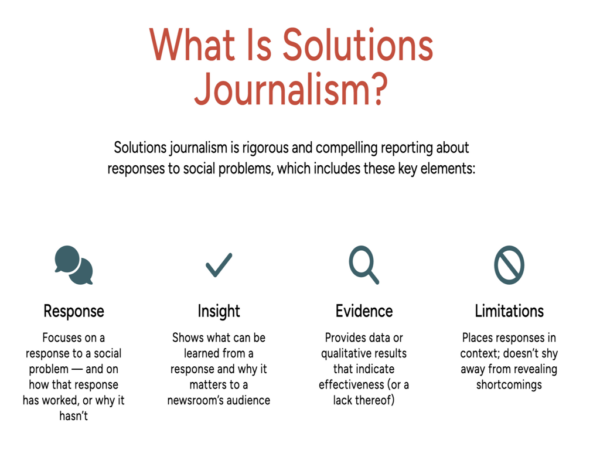
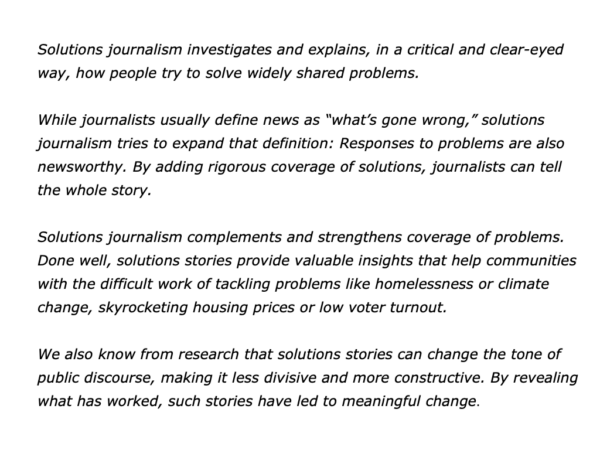
Imagine that you have clarified the strategies most likely to succeed when tackling your chosen challenge. You will then move into action. This involves taking the next step.
You Can Do Your Best To
Achieve The Picture Of Success
Great workers do their best to achieve their goals. They aim to follow their chosen strategies, follow good habits and deliver consistently high standards.
Such workers also keep reading reality. They build on what is going well and tackle areas for improvement. Some follow their successful pattern for finishing and reach the goals by adding that touch of class.
There are many models that people can follow to do fine work. Some people, teams and organisations follow elements of the Appreciative Inquiry approach. Here is an overview of this approach.
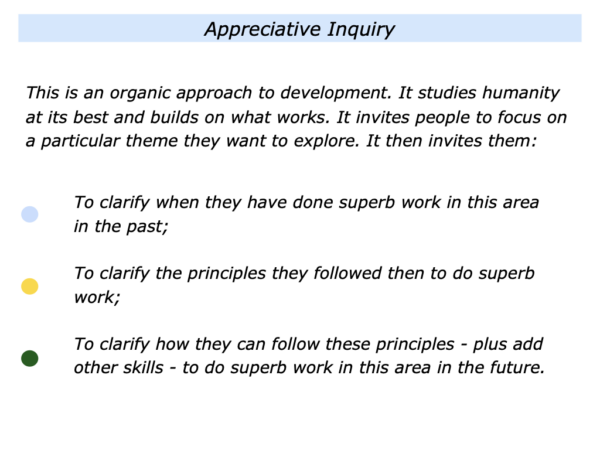
David Cooperrider began developing Appreciative Inquiry in the early 1980s. At that time he was completing his doctorate by doing organisational development work at The Cleveland Clinic.
He began with traditional change management questions, looking at deficits and gaps in performance. Then something happened. Impressed by the co-operation and innovation he found, he focused more on people’s strengths and professional high points.
David began helping people, teams and organisations to find and follow their successful patterns. Joined by other pioneers, he and Diana Whitney co-authored the first book on the topic. This was called Appreciative Inquiry: A positive revolution in change.
AI can be used with small and big groups. Sometimes it can involve thousands of people. It enables them to tackle challenges in their daily lives, work and communities.
People start by Defining the theme, challenge or question they want to explore. They then go through the stages of focusing on Discovery, Dream, Design and Delivery. Let’s explore these themes.
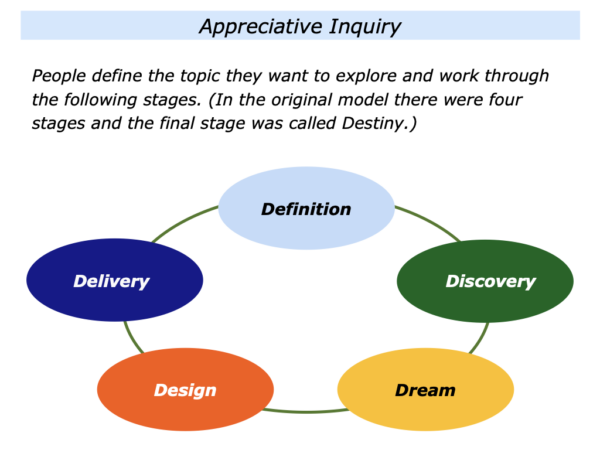
Definition
AI starts by inviting people to define the particular topic they want to explore. Here are examples of what they may focus on but they will define their own chosen topic.
How can we work well together? How can we develop successful new products? How can we tap into the creativity in our organisation? How can we find solutions that – as far as possible – benefit all the stakeholders? How can we build a superb organisation?
When defining the theme it can be useful to follow certain guidelines. These include the following:
To define the theme, challenge or question they want to explore;
To frame this in a positive way – because this determines the way in which people will channel their energy;
To frame it as a question, such as ‘How can we …’
Defining the topic is crucial. It creates the framework within which people can channel their positive energy. People can then embark on the next stage of the AI process.
Discovery
The Discovery phase taps into the positive core – the life-giving forces of a team, organisation or community. It encourages people to build on their inner strengths and successful patterns.
Imagine that you are using this approach with a group of people who have defined the topic they want to explore. They have also defined it in terms of: “How can we …?” Invite people to form small groups and each person:
To describe a specific situation in the past when they – or the team they were part of at that time – did superb work in this area;
To describe the specific things they did right then – the various principles that people followed – to do superb work;
To describe the specific things they did to translate these principles into action and what happened as a result.
Invite people to present their findings back to the big group. Here is one framework they can use. They can then move on to the next stage.

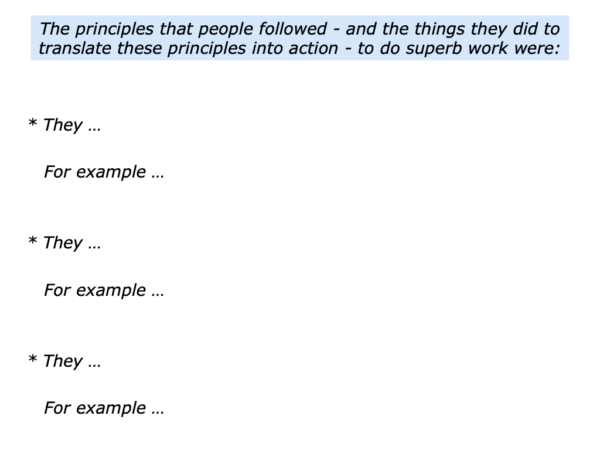
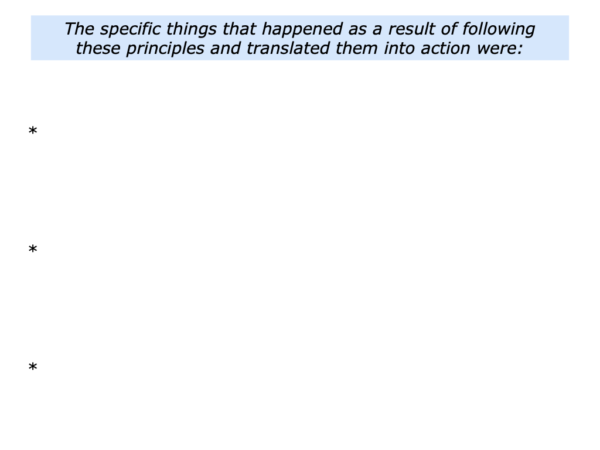
Dream
Appreciative Inquiry is different from most visioning approaches in a crucial way. It builds on the stories, strengths and successful principles that have already emerged. People are doing several things.
They are building on the organic principles they know work;
They are then more confident about extrapolating these principles into the future;
They see how these principles might be expressed in a picture of success.
People may be dreaming but, because they are following successful principles, they have a belief they can deliver. This is because they have started from within. The dream is organic rather than something grafted on.
AI practitioners find the Dream and Design parts sometimes start to overlap. This is okay, because there is often a moving forwards and backwards between the two elements.
There are, however, a few things to mention in relation to defining the dream. It can be useful:
To make sure the dream is an expression of the principles that people know have worked already;
To make sure the dream is stimulating, stretching and yet within the scope of the controllables – the things they can control in the situation;
To, if appropriate, invite people to make a picture – or other representation – of them achieving the dream.
People can draw a picture to show what will actually be happening when they reach the goal. They can bring this to life by adding the actual words they want to be hearing from customers, colleagues, the press and other stakeholders. They can then put the picture in a place where they see it each day.
One key point is worth underlining. People who deliver a dream are often positive realists. They have a positive approach but they are also realistic.
They are like mountain climbers. They focus on achieving a particular goal but also do their due diligence. Such people often go through the following stages when exploring the potential project.
They clarify the benefits – for all the stakeholders – of achieving the goal … They clarify the pluses and minuses involved in working towards achieving the goal … They clarify how to build on the pluses and minimise the minuses.
They clarify whether they are prepared to accept the whole package … They check their motivation by asking: “On a scale 0–10, to what extent are we really serious about doing what is required to achieve the goal?” … They make sure the rating is at least 8+/10.
Here is a framework people can follow during the Dream stage. They can then present these findings to the whole group.
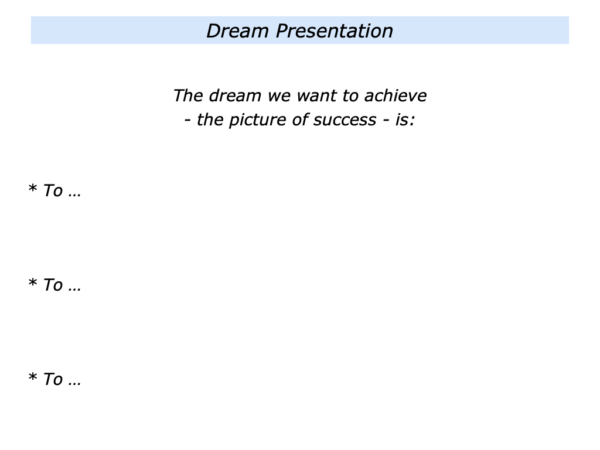
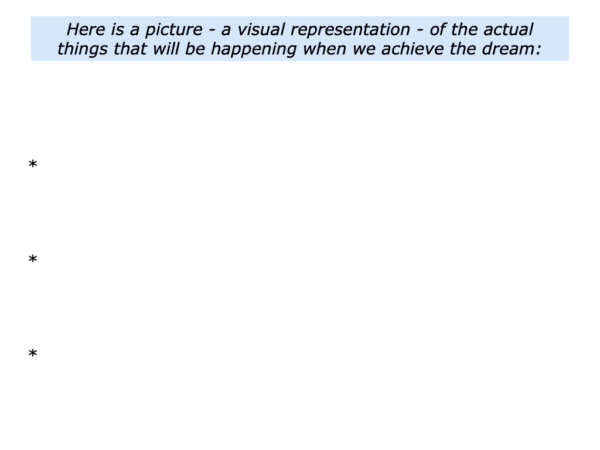
Design
The Dream is the What – the real results to achieve – and the Why – the benefits of achieving the goal. The Design is the How – the strategies for achieving the goal.
Different people use different approaches to clarify their strategies. You will, of course, have your own method. Here is one approach. Bearing in mind the picture of success, people who work in a team may ask some of the following questions.
What are the key strategies we can follow to give ourselves the greatest chance of success? How can we implement these strategies successfully? What support will people need to deliver success?
What are people’s best contributions towards achieving the goals? What are people’s strengths? How can we build on and co-ordinate these strengths to reach the goal? How can we do any remaining tasks that must be completed?
How can we make clear contracts with people about their best contributions? How can we encourage them to do superb work? How can we manage them by outcomes rather than by tasks?
What are the potential difficulties people may face along the way? How can we anticipate and prevent these difficulties happening? How can we manage the difficulties if they do happen?
What is the road map – the action plan – for achieving the dream? Who will need to deliver what and by when? What will be the actual things that will be happening that will show we have reached the goal?
Imagine you are leading a team that is taking these steps. You can invite people to clarify the key strategies they will follow to achieve the goals.
If appropriate, people can then form small teams where they focus on their elements of implementing the strategy. They then can present these back to the whole group.
They can start their presentations, however, by completing the following headlines. Then, if appropriate, they can break these down into more detailed action plans.
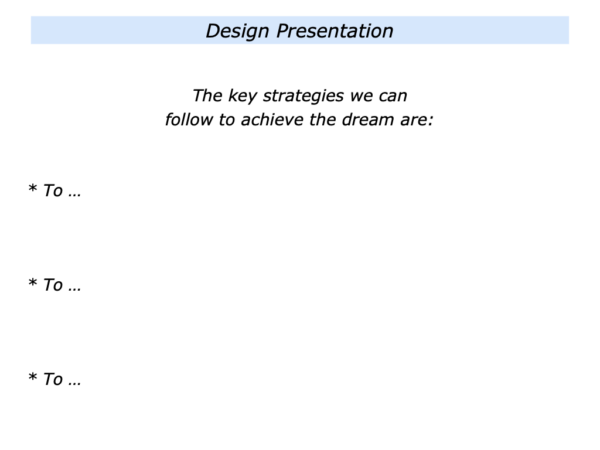
Delivery
The Delivery phase translates the dream into reality. People throw themselves into the work and get some early wins.
Maintaining the momentum is crucial, so it is vital to have follow up meetings. One approach is to gather people together at least once a month to report their progress.
If you are running such sessions, keep people’s eyes on the big picture. You can start, for example, by reminding people of the Dream. People can then be invited to present the following things.
The specific things they have delivered in the past month towards achieving the dream;
The specific things they plan to deliver in the next month;
The specific challenges they face and their plans for tackling these challenges;
The specific support they would like to help to deliver the dream;
The specific other topics they would like to explore regarding how to deliver the dream.
You can encourage people to build on their successes and develop the habit of constant improvement. This will increase the chances of achieving the goal.
Different people apply AI in different ways. Whichever approach they use, however, they invite individuals, teams or organisations to build on their positive core.
This approach can be used with small and big groups. Sometimes it can involve thousands of people. They are asked to share their ideas to help shape the future.
In my own work I have used elements of it when working with organisations in business. Every time that people have applied the approach properly they have delivered success.
Let’s return to your own work and the stimulating challenge you may want to tackle. This starts by clarifying the results you want to achieve. It then involves building on your strengths, following strategies that work and doing your best achieve the picture of success.
Looking to the future, can you think of a situation where you may want to follow elements of this approach? How can you follow it in your own way? What may happen as a result of taking these steps?
If you wish, try tackling the exercise on this theme. This invites you to complete the following sentences.
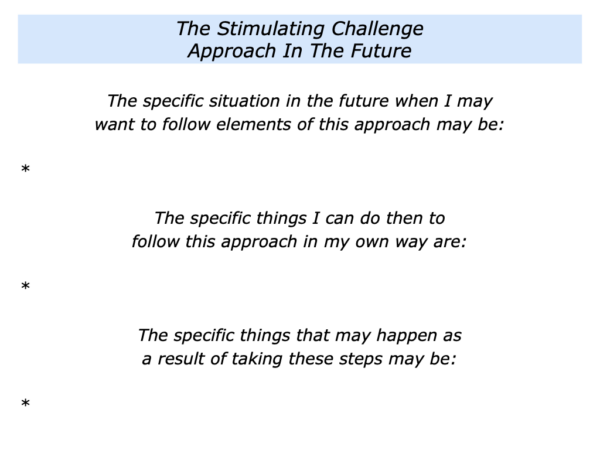


Leave a Reply